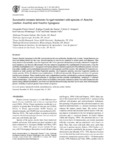Use este identificador para citar ou linkar para este item:
http://www.alice.cnptia.embrapa.br/alice/handle/doc/1029193Registro completo de metadados
| Campo DC | Valor | Idioma |
|---|---|---|
| dc.contributor.author | FAVERO, A. P. | pt_BR |
| dc.contributor.author | SANTOS, R. F. dos | pt_BR |
| dc.contributor.author | SIMPSON, C. E. | pt_BR |
| dc.contributor.author | VALLS, J. F. M. | pt_BR |
| dc.contributor.author | VELLO, N. A. | pt_BR |
| dc.date.accessioned | 2015-11-23T11:11:11Z | pt_BR |
| dc.date.available | 2015-11-23T11:11:11Z | pt_BR |
| dc.date.created | 2015-11-23 | pt_BR |
| dc.date.issued | 2015 | pt_BR |
| dc.identifier.citation | Genetics and Molecular Biology, v. 38, n. 3, p. 353-365, sep. 2015. | pt_BR |
| dc.identifier.uri | http://www.alice.cnptia.embrapa.br/alice/handle/doc/1029193 | pt_BR |
| dc.description | Peanut (Arachis hypogaea) is the fifth most produced oil crop worldwide. Besides lack of water, fungal diseases are the most limiting factors for the crop. Several species of Arachis are resistant to certain pests and diseases. This study aimed to successfully cross the A-genome with B-K-A genome wild species previously selected for fungal disease resistance, but that are still untested. We also aimed to polyplodize the amphihaploid chromosomes; cross the synthetic amphidiploids and A. hypogaea to introgress disease resistance genes into the cultivated peanut; and analyze pollen viability and morphological descriptors for all progenies and their parents. We selected 12 A-genome accessions as male parents and three B-genome species, one K-genome species, and one A-genome species as female parents. Of the 26 distinct cross combinations, 13 different interspecific AB-genome and three AA-genome hybrids were obtained. These sterile hybrids were polyploidized and five combinations produced tetraploid flowers. Next, 16 combinations were crossed between A. hypogaea and the synthetic amphidiploids, resulting in 11 different hybrid combinations. Our results confirm that it is possible to introgress resistance genes from wild species into the peanut using artificial hybridization, and that more species than previously reported can be used, thus enhancing the genetic variability in peanut genetic improvement programs. | eng |
| dc.language.iso | eng | pt_BR |
| dc.rights | openAccess | pt_BR |
| dc.subject | Peanut | pt_BR |
| dc.subject | Interspecific hybrids | pt_BR |
| dc.subject | Polyploidization | pt_BR |
| dc.subject | Pollen viability | pt_BR |
| dc.title | Successful crosses between fungal-resistant wild species of Arachis (section Arachis) and Arachis hypogaea. | pt_BR |
| dc.type | Artigo de periódico | pt_BR |
| dc.date.updated | 2016-01-27T11:11:11Z | pt_BR |
| dc.subject.nalthesaurus | colchicine | pt_BR |
| riaa.ainfo.id | 1029193 | pt_BR |
| riaa.ainfo.lastupdate | 2016-01-27 | pt_BR |
| dc.identifier.doi | 10.1590/S1415-475738320140376 | pt_BR |
| dc.contributor.institution | ALESSANDRA PEREIRA FAVERO, CPPSE; RODRIGO FURTADO DOS SANTOS, CNPAE; CHARLES E. SIMPSON, TEXAS AGRILIFE RESEARCH -TEXAS A&M UNIVERSITY/STEPHENVILLE; JOSE FRANCISCO MONTENEGRO VALLS, CENARGEN; NATAL ANTONIO VELLO, ESALQ/PIRACICABA. | pt_BR |
| Aparece nas coleções: | Artigo em periódico indexado (CPPSE)  | |
Arquivos associados a este item:
| Arquivo | Descrição | Tamanho | Formato | |
|---|---|---|---|---|
| alessamdrafavero.pdf | 817,43 kB | Adobe PDF |  Visualizar/Abrir |









